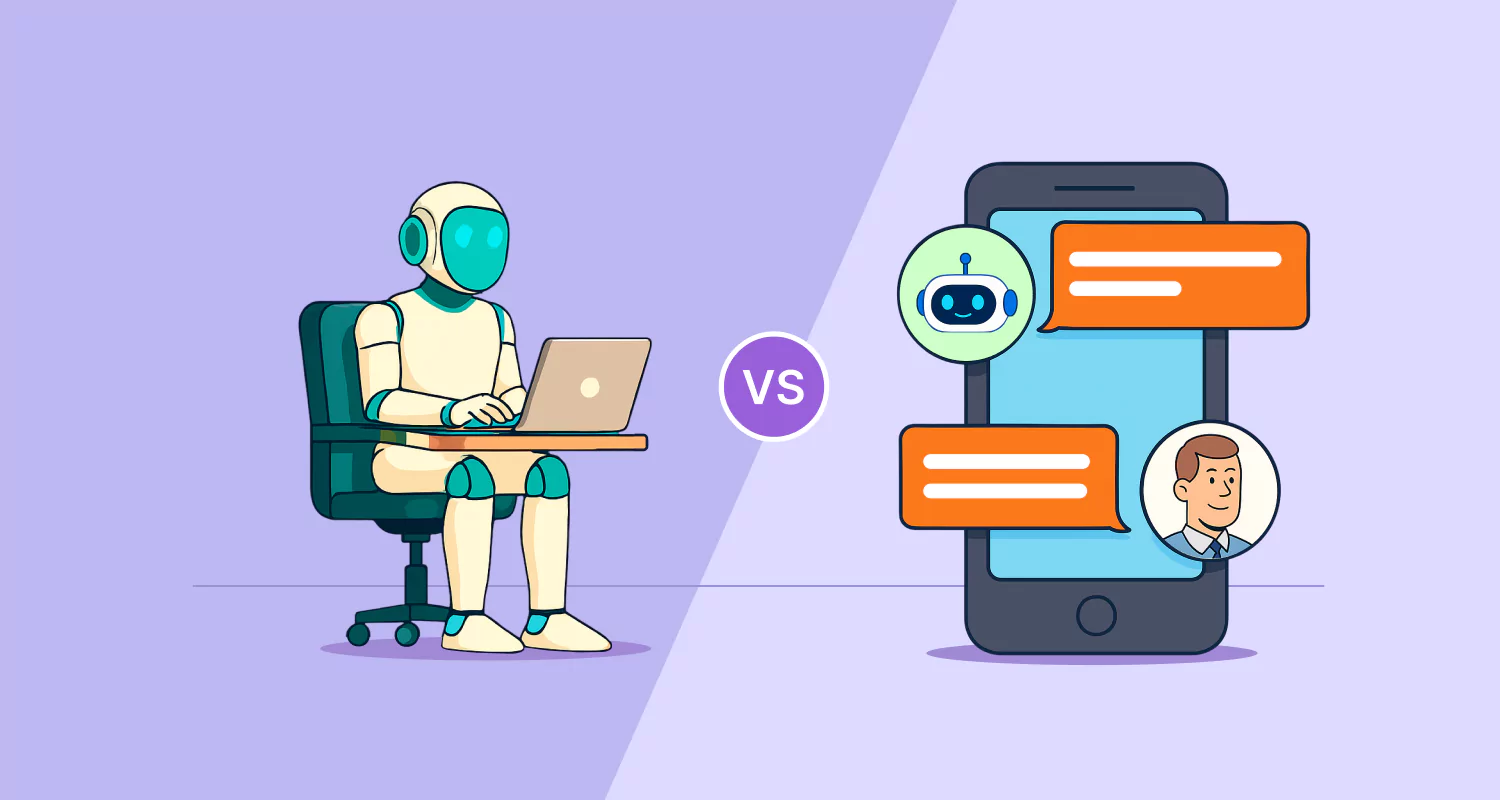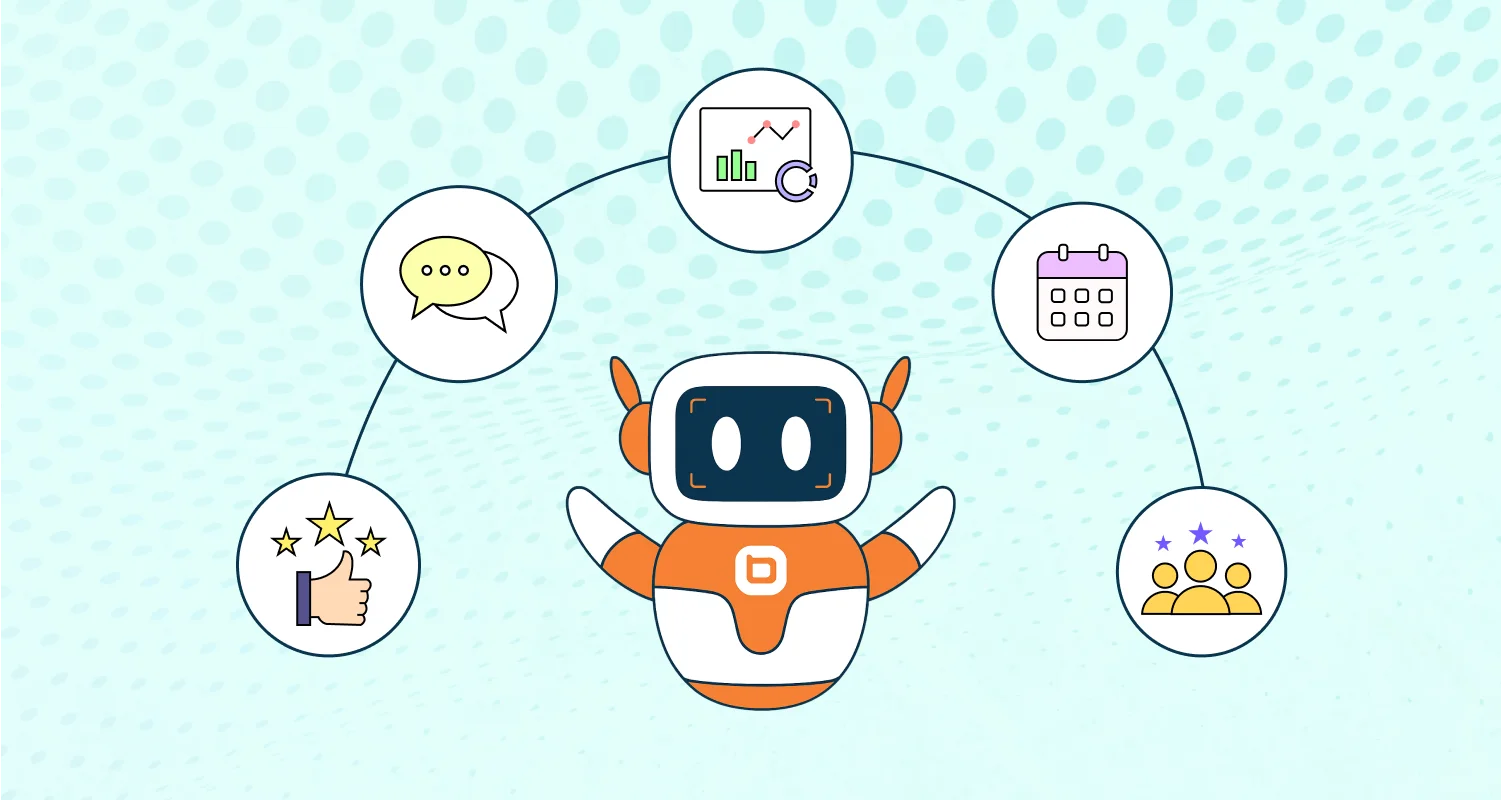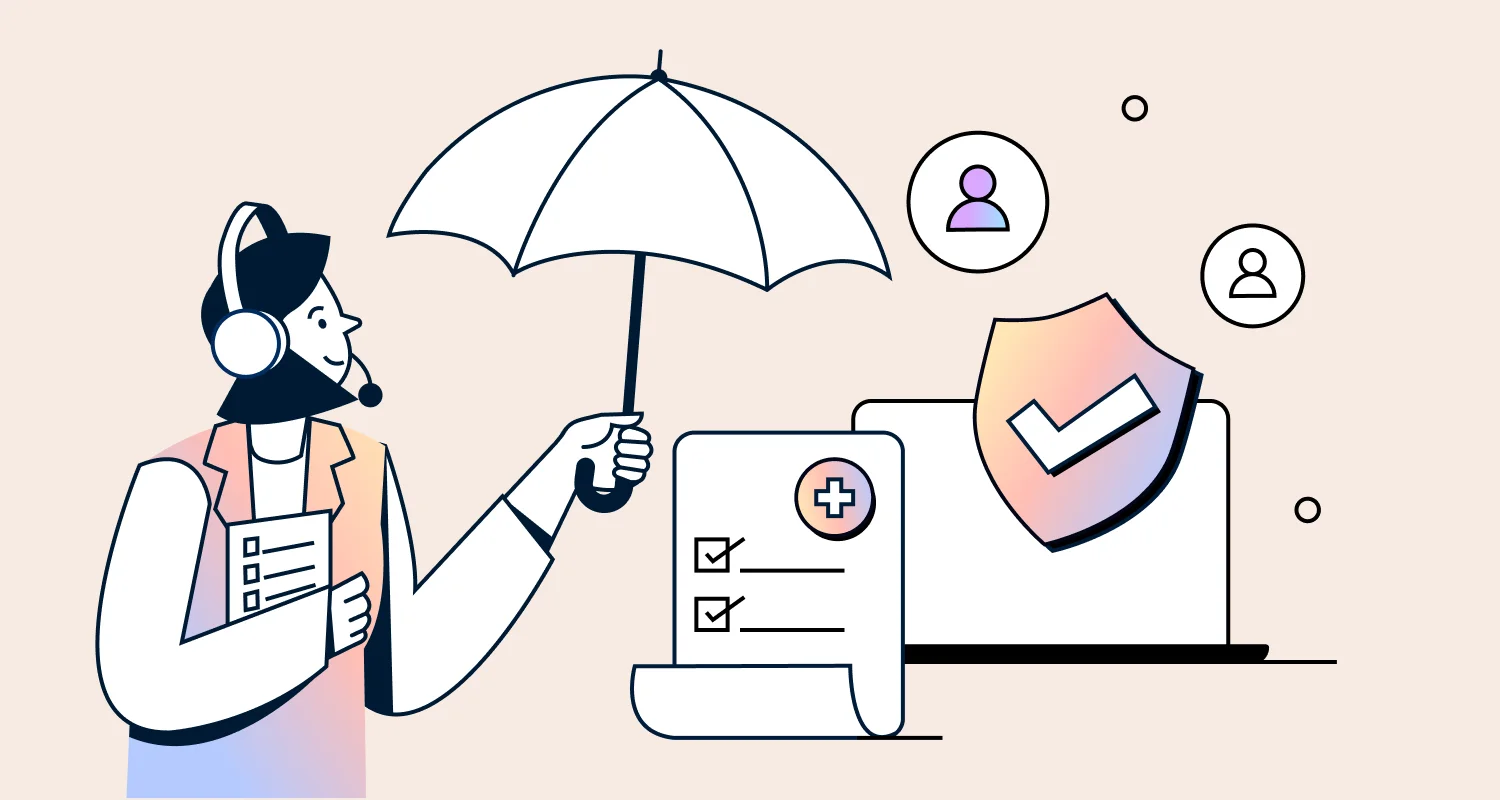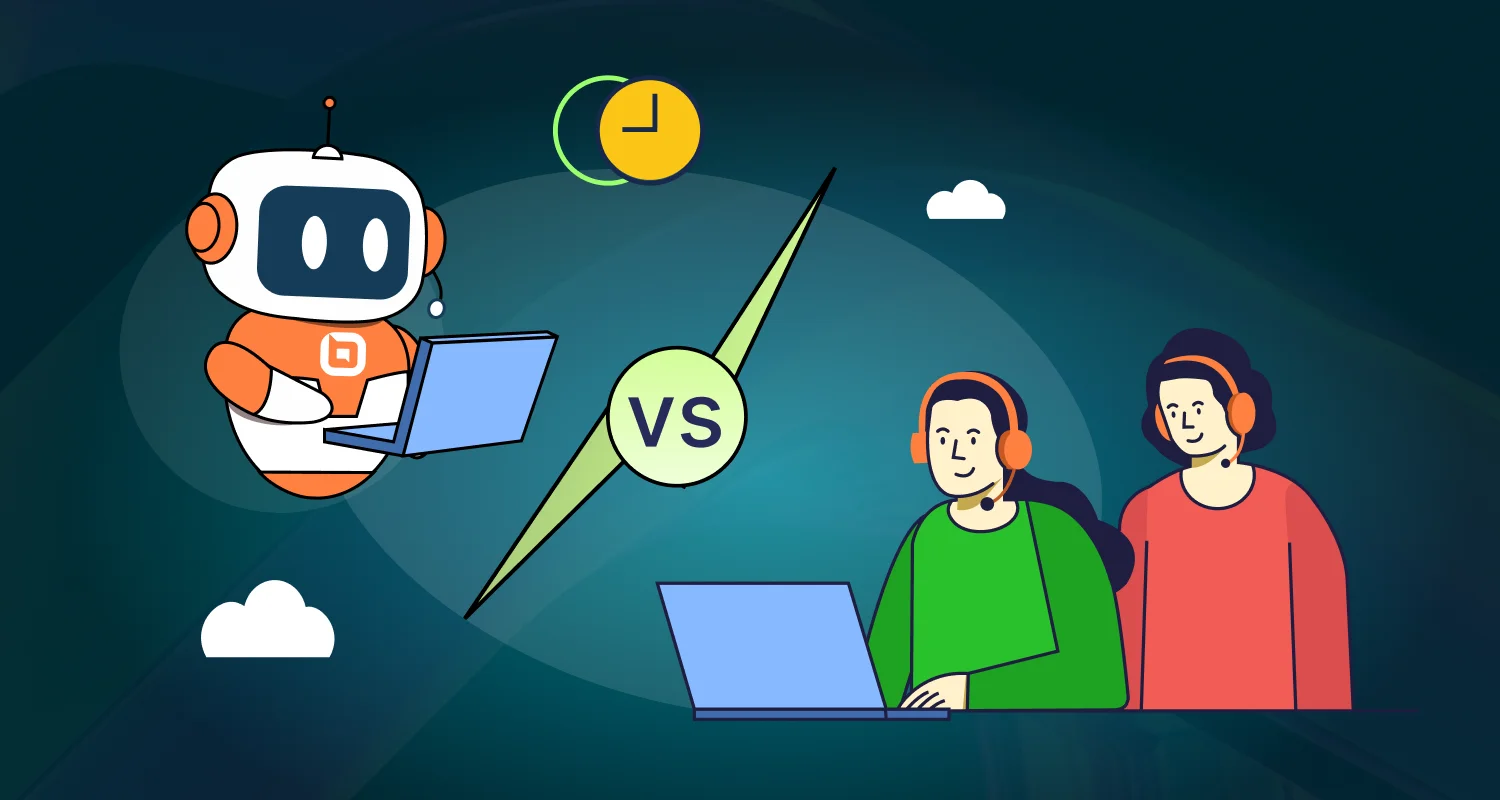You’ve likely interacted with conversational AI for customer service more often than you realize. Maybe it was a chatbot that stuck you in a loop of generic replies or a voice assistant that seemed to anticipate your needs with surprising accuracy.
From asking Google Assistant for directions to chatting with a support bot at midnight, AI is reshaping how we communicate and solve everyday problems.
In fact, with over 85% of companies now using AI in some form, understanding the difference between an AI agent vs chatbot has never been more important.
While both aim to streamline operations and enhance customer experiences, AI agents and chatbots are built for fundamentally different roles and capabilities.
In this blog, we’ll break down the key differences between AI agent vs chatbot, explore practical examples, and help you decide which solution best meets your customer support needs.
What is an AI agent?
An AI agent is an intelligent system that uses advanced AI technologies such as machine learning and large language models (LLMs) to understand user intent, plan actions, and autonomously execute tasks.
Unlike traditional chatbots that rely on scripted responses, AI agents can learn from past interactions, adapt to new information, and access external data sources to solve complex, multi-step tasks.
With the ability to make decisions and take independent actions to achieve specific goals, AI agents are ideal for dynamic environments like customer support, supply chain management, manufacturing, and workflow automation.
What is a chatbot?
A chatbot is an AI-powered program designed to simulate human-like conversations through text or voice interactions.
Chatbots follow pre-programmed rules or scripts to handle simple, repetitive tasks like answering frequently asked questions.
AI chatbots are often embedded in an ecommerce website to provide instant responses to customer inquiries, such as order updates, but within limited, predefined scenarios.
Differences between an AI agent vs chatbot
Although AI agents and chatbots may seem similar on the surface, their capabilities, complexity, and roles in automation reveal some key differences worth exploring.
Understanding these differences is key to unlocking the full potential of AI in business, customer service, and beyond.
Let’s dive into what sets an AI agent apart from a chatbot and why it matters.
| Feature | Chatbots | AI agents |
| Intelligence level | Confined to predefined responses | Predictive, autonomous decision-making |
| Learning capabilities | Limited learning from interactions | Continuous learning and improvement |
| Autonomy and decision-making | Reactive, only responds when prompted | Proactive, can initiate conversations |
| Personalization | Basic personalization, like username and preferences | Dynamic and adaptive personalization based on user behavior and data |
| Integration and deployment | Works with basic messaging platforms | Extensive integration across advanced tools and APIs |
| Best for | Ideal for businesses with straightforward tasks | Businesses with complex needs and a focus on long-term automation |
Intelligence level
Chatbots rely on scripted responses and decision trees, which means they can only answer questions they’ve been specifically programmed for. They may respond with irrelevant answers or loop back to basic replies when faced with unfamiliar questions.
By contrast, AI agents have a broader and more flexible grasp of information. They can access multiple data sources, retrieve real-time updates, and continuously expand their knowledge by learning from new inputs and evolving topics.
Learning capabilities
Chatbots operate on fixed rules and pre-programmed scripts. They respond to specific keywords with set answers, which limits their ability to handle dynamic conversations. Without manual updates from developers, they struggle to adapt or improve over time.
AI agents continuously learn from interactions, understand natural language and user intent, and adapt their responses based on evolving data, policies, or product updates. This ability makes them smarter over time.
Gartner predicts AI agents will progress from basic assistants embedded in business applications to task-specific agents by 2026.
Autonomy and decision making
Chatbots primarily respond based on user input. They follow set rules and scripts, so they can only handle simple, repetitive tasks and can’t make decisions autonomously.
AI agents, on the other hand, work more independently and can:
- Initiate conversations
- Analyze data in real time
- Make informed decisions without human input
In fact, a study by ControlHippo reports that AI agents can increase task automation efficiency by 45%.
They can also handle complex tasks by understanding context, predicting outcomes, and escalating only when necessary.
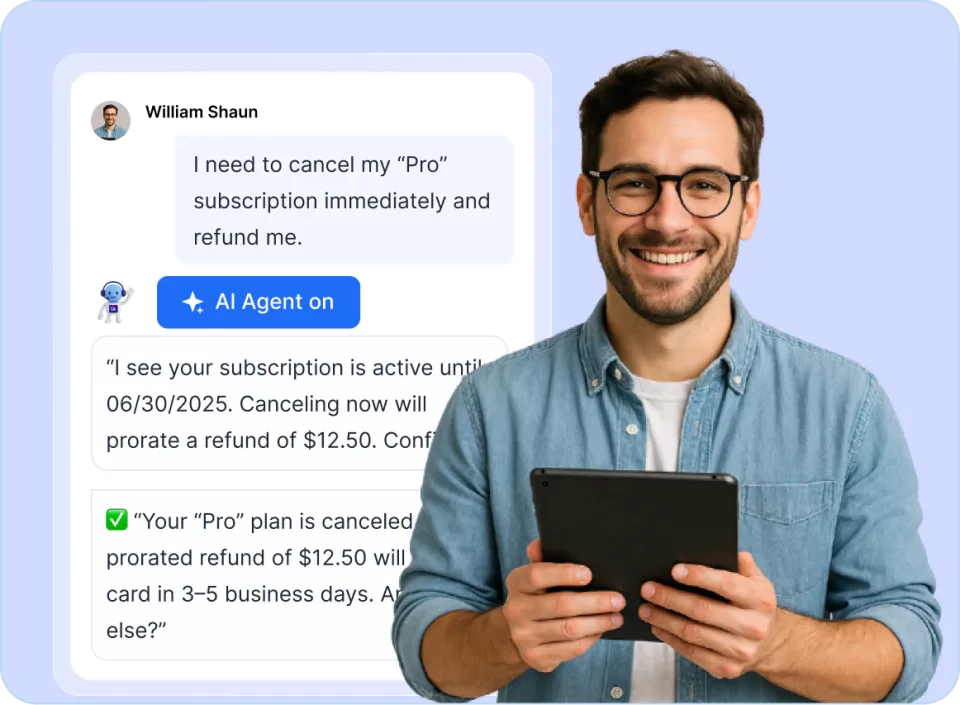
Personalization and context-awareness
Chatbots offer basic personalization, such as using your name or remembering your last question within a session. They maintain a consistent tone and style but often feel scripted and limited, especially when handling unexpected input.
AI agents offer deep personalization. They can:
- Learn your preferences
- Adapt their tone and suggestions
- Tailor responses based on your history and behavior
Over time, they build a deeper understanding of user needs, making interactions feel more human and intuitive.
Integration and deployment
Chatbots usually have limited integration capabilities, often connecting to just one or two systems for basic tasks like retrieving data from a knowledge base.
Unlike chatbots, AI agents are built for deep integration. They can connect with multiple platforms, such as CRMs, knowledge bases, ticketing systems, and project management tools, to boost efficiency and carry out complex tasks.
How to choose between an AI agent vs chatbot
In a world where AI is rapidly reshaping how we work and interact, understanding the tools at your disposal is essential.
“Artificial intelligence will not replace humans, but those who use AI will replace those who don’t.” Ginni Rometty, former CEO of IBM.
This quote captures a critical truth in today’s digital landscape: leveraging AI is no longer optional—it’s strategic.
Choosing between an AI chatbot and an AI agent depends on your goals—whether you need simple conversations or intelligent, autonomous task execution.
Here’s how to make the right call.
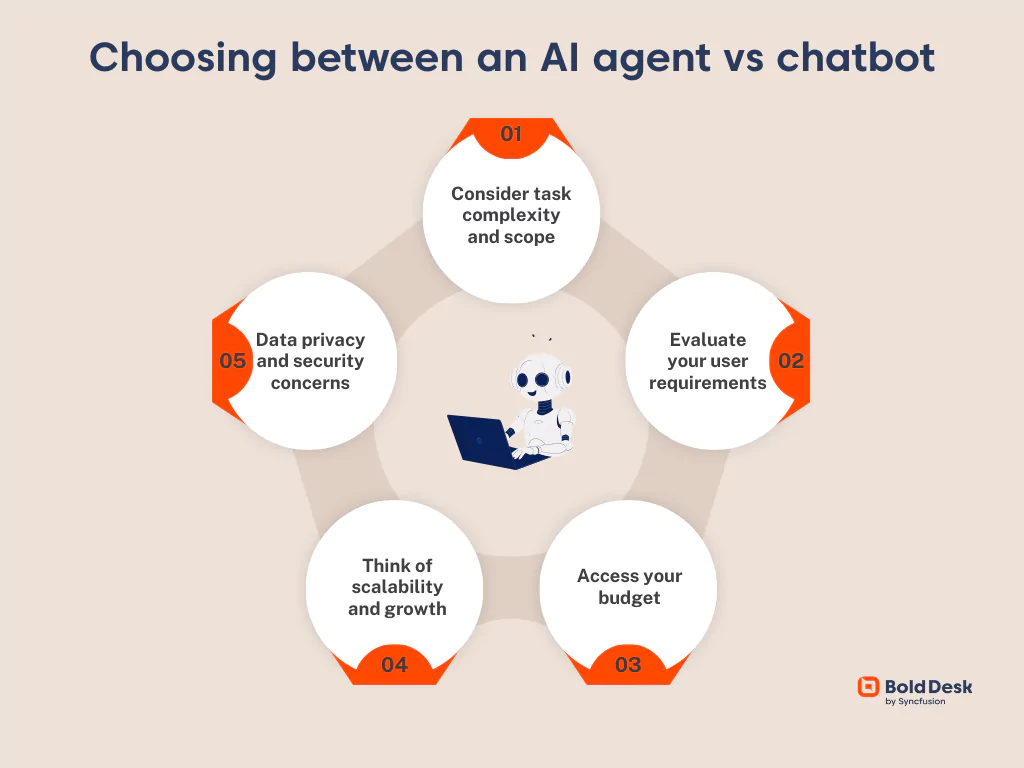
Consider task complexity and scope
Access the complexity of the tasks that you want to automate. If your daily interactions mostly involve repetitive tasks such as booking appointments, FAQs, or guiding users through simple workflows, an AI chatbot can do.
Chatbots resolve 90% of queries in under 11 messages, but are often limited to scripted or FAQ-based interactions.
If your needs involve multi-step reasoning, decision-making, or actions across systems—such as processing returns, troubleshooting technical issues, or analyzing real-time data, an AI agent is better suited.
Evaluate your user requirements
Think about the experience your customers expect. If speed and consistency are key, like getting quick answers to FAQs or navigating a support menu, a chatbot delivers reliable, fast responses.
When users need personalized, adaptive conversations in which the AI remembers past interactions, adjusts tone, and handles complex or emotional queries, an AI agent provides a more human-like experience.
If your goal is to deliver a smooth, personalized, and engaging experience, especially for more complex or emotional customer needs, AI agents are a better choice.
Access your budget
Be realistic about what you can invest—both upfront and over time. Your financial capacity is key in choosing between an AI chatbot and an AI agent.
AI chatbots are typically faster and cheaper to build and maintain. They work well with limited data and don’t require complex integrations.
AI agents demand more investment in development, training, and infrastructure. They often need access to multiple data sources and ongoing tuning.
Think of scalability and growth
Consider how your customer needs might evolve. Chatbots are great at handling large volumes of simple, repetitive tasks. However, they often struggle to adapt or scale effectively as your business grows and customer needs become more complex.
AI agents are built to learn through feedback loops, improve over time, and scale with your organization. They’re ideal if you’re planning long-term automation or digital transformation.
Data privacy and security considerations
Protecting user data is non-negotiable, no matter which tool you choose.
AI chatbots are generally easier to secure since they handle limited, low-risk data such as appointment scheduling. This makes them suitable for organizations with basic privacy needs.
However, they must still comply with regulations like GDPR or local data protection laws.
AI agents often access more sensitive data across multiple systems, such as billing details, which makes them more vulnerable to threats like phishing attacks or data leaks.
To mitigate these risks, businesses should implement strong security measures, such as encryption, role-based access controls, and regular audit trails.
Use cases of AI agents and chatbots in customer service
Chatbots and AI agents may use conversations, but they serve different purposes. Chatbots handle quick, repetitive tasks, while AI agents tackle complex, goal-driven workflows.
Here’s where each tool works best—and why choosing the right one matters.
Chatbot use cases
Chatbots operate based on scripted responses and decision trees, making them reliable for straightforward queries.
The following are some of the AI chatbot use cases:
Answering FAQs
A retail brand could use a chatbot to answer common questions like “Is there a free plan available?” or “What’s your return policy?” instantly.
The chat bot matches customer queries to scripted responses, providing prompt replies to basic support inquiries, reducing wait times, and improving customer satisfaction.
Basic lead qualification
Businesses can use chatbots to qualify leads by identifying which visitors are genuinely interested in their products or services. Chatbots engage users in conversation, ask relevant questions, and collect basic information, such as their needs or intent.
Typical AI chatbot online prompts include:
- “Would you like to book a demo?”
- “Can I get your email to send more details?”
Order status inquiries
An online store could use a chatbot for ecommerce to help customers track their orders, check estimated delivery dates, and report missing items.
Real-life example:
Sephora’s bot provides customers with real-time updates on shipping, delivery timelines, and order history, providing 24/7 automated support.
First-level IT support
A business could use a chatbot to guide customers through simple troubleshooting steps for basic technical support issues. The bot could help customers solve common issues without waiting for a human agent.
Examples include:
- “Send me a password reset link.”
- “How do I install the VPN?”
Employee self-service
An organization could use a chat bot to assist employees with checking leave balances, downloading pay slips, updating personal details, and finding company policies.
Examples include:
- “How many leave days do I have left?”
- “Where can I find the travel reimbursement policy?”
AI agent use cases
AI agents are designed for complex, multi-step tasks that require autonomy, context awareness, and integration with external systems.
According to McKinsey, AI agents—especially those powered by large language models, could contribute up to $4.4 trillion in productivity growth across corporate use cases.
Here’s where a business might use an AI agent:
Refund automation
AI agents in customer service can help ecommerce businesses handle end-to-end refund processes, all without human intervention.
AI agents can:
- Validate purchase history
- Apply refund policies
- Trigger refund transactions
- Send confirmation emails
Real-life example:
Amazon‘s Alexa acts as a voice-enabled shopping assistant. Users can reorder items, get personalized recommendations, and control smart home devices. Alexa is integrated into Amazon’s ecosystem to streamline ecommerce customer service.
Scheduling and coordination
A consulting firm could deploy an AI agent as a virtual executive assistant. The agent can coordinate meetings across time zones, resolve conflicts, prioritize urgent appointments, and suggest optimal times based on participants’ availability and workload.
Intelligent customer journey mapping
A telecom company could use an AI agent to analyze customer behavior across channels, such as phone, chat, and app usage. The agent could then trigger retention workflows like personalized offers or proactive outreach.
Billing issue resolution
A subscription-based SaaS company could build an AI agent to handle billing-related inquiries. The agent can access billing systems to verify transactions, apply company policies to determine refund eligibility, and generate and send updated invoices or receipts autonomously.
Building powerful AI agents with BoldDesk
BoldDesk’s AI agent is a fully autonomous support assistant designed to think, act, and resolve issues like a human, but with the speed and accuracy of AI.
Unlike traditional chatbots that rely on scripts and decision trees, BoldDesk’s AI agent understands context, adapts to customer needs, and executes real-time actions without human intervention.
From processing refunds and updating orders to answering complex queries using your knowledge base, this AI agent is built to deliver smarter, faster, and more personalized support—24/7.
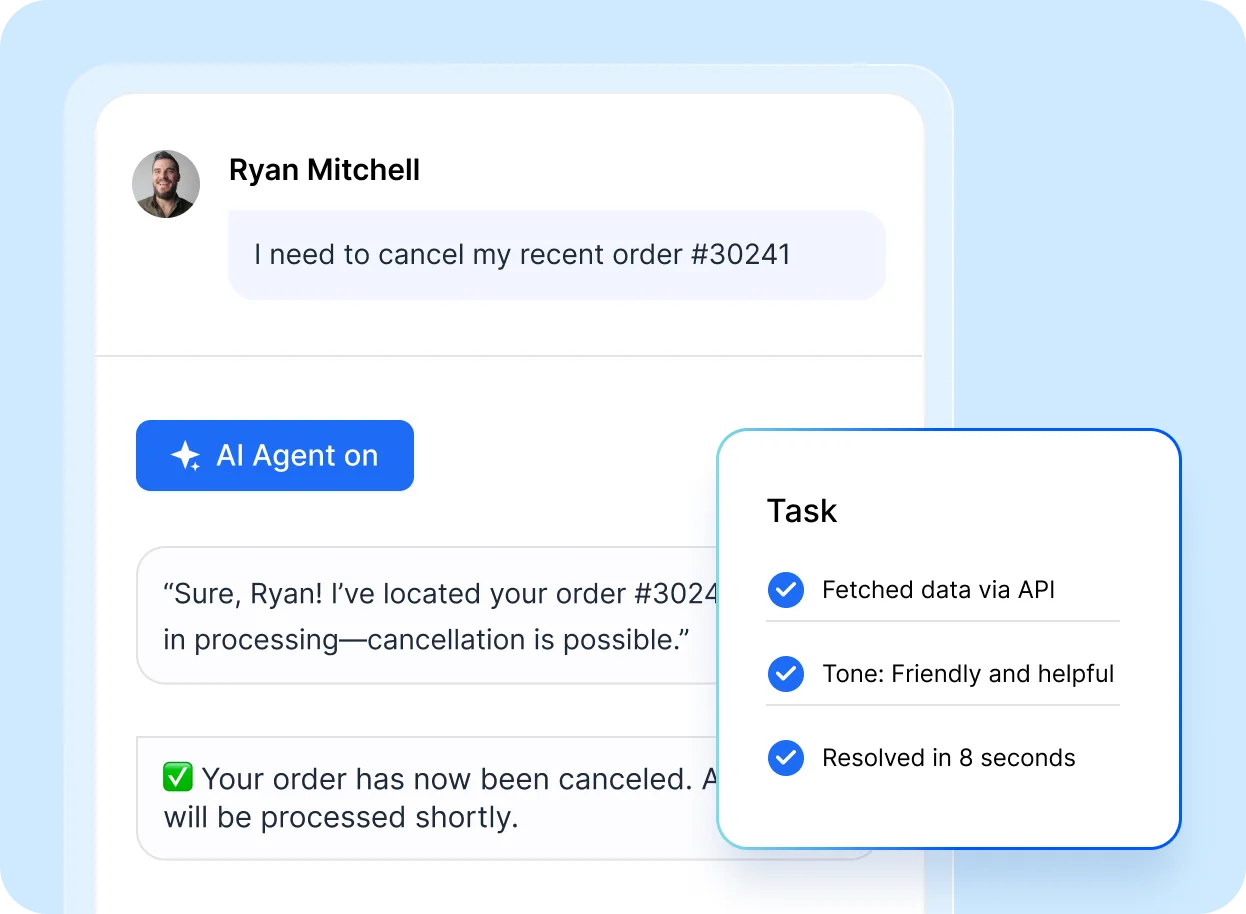
Key features of BoldDesk’s AI agent
- AI Actions: Enables AI agents to integrate with external APIs to perform real-time, automated tasks, such as canceling orders, updating customer information, or retrieving shipment statuses, without human intervention.
- Customizable tone: Allows you to adjust the communication style (friendly, professional, casual) and response length to match your brand.
- Knowledge-based responses: Pulls accurate answers from your knowledge base, custom replies, and uploaded documents.
- Multilingual support: Translates and responds in multiple languages for global customer engagement.
- Sentiment and intent detection: The context aware AI understands customer emotions and intent to prioritize and personalize interactions.
- Fast deployment: Easily integrates into live chat or support portals with quick, no-code setup.
- Robust reporting and analytics: Monitors real-time performance with live dashboards that track AI usage by features and agents. Instantly reviews what the AI successfully handled and what it escalated to human agents.
AI agent vs chatbot: Ready to decide?
Choosing between an AI agent vs AI chatbot goes beyond technology. It is about how you want to support your customers.
While chatbots offer basic, reactive assistance, AI agents provide more intelligent, proactive support through deeper system integration.
Your decision should align with your business goals, support complexity, and customer expectations.
Platforms like BoldDesk are built with the future in mind. Its robust AI agent empowers support teams to respond faster, work smarter, and deliver more personalized service.
Contact our support team to see how our AI agent can transform your customer support operations.
We hope this blog helped clarify the differences between AI agents vs chatbots in customer service. Have any thoughts or questions? Please share them in the comments below!
Related articles
- Chatbot vs Live Chat in 2025: Which is Best?
- Smarter Support: New Fall 2024 BoldDesk AI Updates
- 7 Best Ways to Utilize AI for Customer Experience
Frequently asked questions
Yes. Many companies use chatbots for FAQs and route complex, multi-step tasks to AI agents for smart automation.
No. They only complement human agents by handling repetitive, routine, or multi-system tasks, freeing humans to focus on empathy and complex problem-solving.
Implementation of AI agents and chatbots is challenging in the following ways:
- Data quality and quantity: AI models need large, clean datasets to perform well. Poor or biased data leads to inaccurate responses.
- Integration complexity: Connecting chatbots to existing systems (CRMs, ERPs, databases) can be technically demanding.
- Human oversight: Ensuring agents can hand over to humans when necessary.
- Latency: Real-time responses require optimized infrastructure and fast processing.
- Governance: Maintaining accuracy, accountability and ensuring compliance with regulatory frameworks like HIPAA and GDPR to prevent hallucination.
Consider your business needs:
- Use a chatbot for simple, repetitive tasks like FAQs and order tracking.
- Choose an AI agent if you need intelligent automation for customer support resolution, lead qualification, or internal operations.
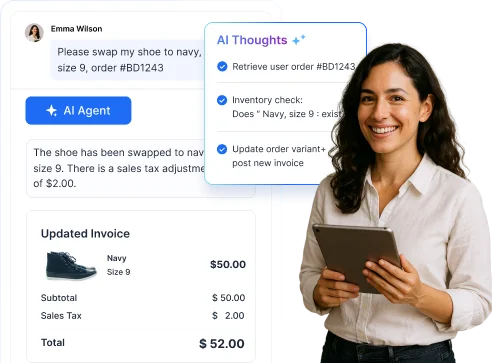


















 Email Ticketing System
Email Ticketing System Shared Inbox Software
Shared Inbox Software Multi Brand Help Desk
Multi Brand Help Desk Internal Help Desk Software
Internal Help Desk Software Trouble Ticketing Software
Trouble Ticketing Software Mobile Help Desk
Mobile Help Desk 









